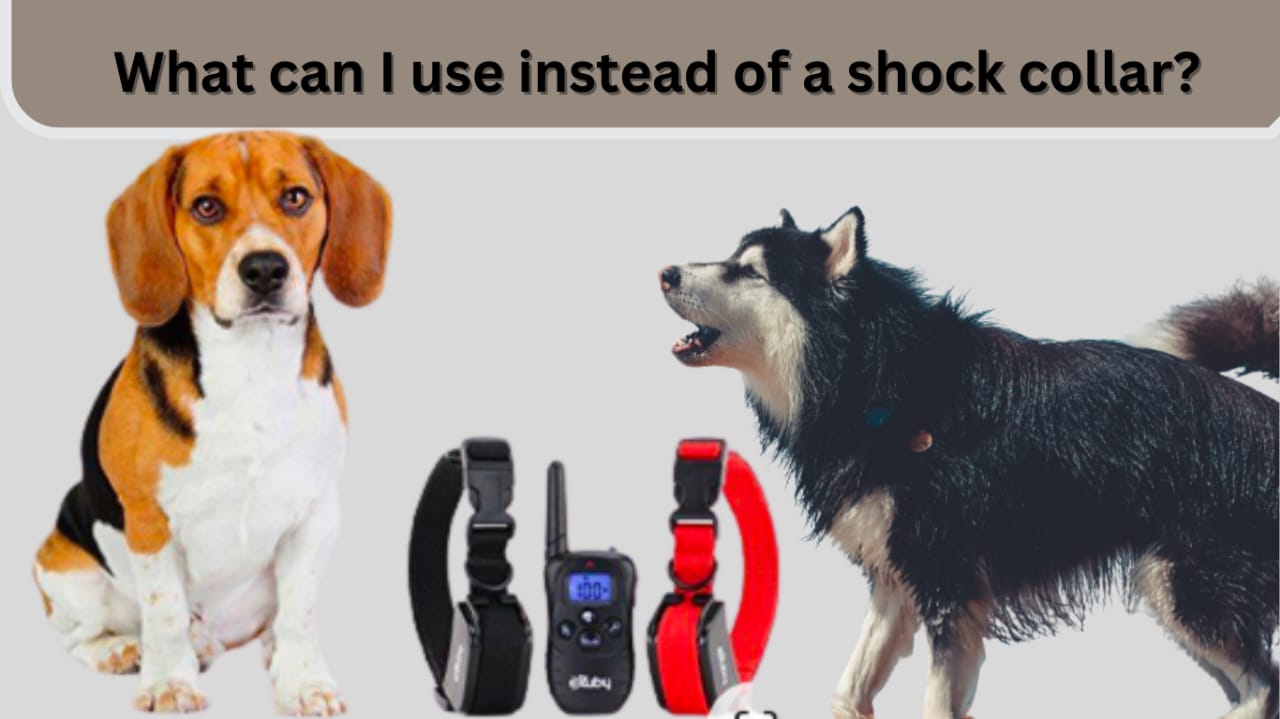Shock Collars: What can I use instead of a shock collar?

What can I use instead of a shock collar?
When it comes to training your furry friend, choosing humane methods that prioritize your dog’s well-being is crucial. This guide will walk you through effective alternatives to shock collars, answering the question, “What can I use instead of a shock collar?” We’ll focus on positive and gentle training techniques.
In our exploration, we’ll delve into options such as positive reinforcement, clicker training, professional classes, ultrasonic devices, citronella collars, remote training collars, harnesses, leashes, and behavior modification strategies.
What can I use instead of a shock collar? Effective Alternatives
Positive Reinforcement Training
Positive reinforcement is a powerful training method. It involves rewarding your dog for good behavior with treats, praise, or toys. This approach creates a positive association with training and helps build trust between you and your dog.
Clicker Training
Clicker training is a technique that uses a small device to make a clicking sound when your dog performs a desired behavior. The clicker serves as an immediate reward marker, helping your dog understand which actions earn praise and treats.
Professional Dog Training Classes
Enrolling in professional dog training classes can be highly beneficial. Certified trainers provide expert guidance in a positive and controlled environment. These classes focus on socialization, obedience, and building a strong bond between you and your dog.
Ultrasonic Devices
Ultrasonic training devices emit high-pitched sounds that are unpleasant to dogs when they misbehave. These devices can deter unwanted behavior without causing harm.
Citronella Collars
Citronella collars release a harmless burst of citronella scent when your dog barks excessively or exhibits undesirable behavior. The scent serves as a gentle deterrent.
Remote Training Collars (Vibration and Sound)
Remote training collars use vibration or sound to get your dog’s attention. They are less invasive than shock collars and can be effective in reinforcing commands and behaviors.
Harnesses and Leashes
Using harnesses and leashes allows for better control during training sessions and walks. Proper leash training techniques combined with positive reinforcement can lead to improved behavior.
Behavior Modification and Consistency
Identifying behavior issues and addressing them through consistent training techniques is essential. Patience and a long-term approach can help your dog develop better behavior habits.
How do you discipline a dog without a shock collar?
Disciplining a dog without a shock collar means teaching them good behavior in a positive and kind way. You can do this by rewarding them when they do something good, like giving them treats or praise. If they’re doing something you don’t like, you can gently redirect their attention to a better activity or use a word like “no” in a calm voice to let them know it’s not okay.
Taking a break, called a time-out, can also help. If your dog is misbehaving, you can briefly separate them from the situation, so they understand that their actions have consequences. It’s important to be consistent in your rules and reactions and to be patient with your furry friend. Building a strong and loving bond with your dog is the most effective way to teach them good behavior, and it doesn’t involve using harsh methods like shock collars.
Do non shock collars work?
Yes, non-shock collars can be effective tools for training dogs. These collars are designed to correct behavior and reinforce commands without using electric shocks. They work in various ways, and their effectiveness largely depends on the dog’s temperament, the training method used, and the consistency of the owner.
Some common types of non-shock collars include:
- Head Collars: Head collars, like the Gentle Leader or Halti, offer control by gently guiding a dog’s head, redirecting its attention, and discouraging pulling.
- Martingale Collars: These collars provide gentle pressure around the dog’s neck when they pull, discouraging leash-pulling without causing harm.
- Spray Collars: These collars release a burst of citronella spray or unscented air when a dog barks excessively, serving as a mild deterrent.
- Vibration Collars: Vibration collars use gentle vibrations to get a dog’s attention or signal commands. They are often used for training deaf dogs.
- Ultrasonic Collars: Ultrasonic collars emit high-pitched sounds that dogs find unpleasant, which can deter barking or unwanted behavior.
- Citronella Collars: These collars release a burst of citronella scent when a dog barks excessively, serving as a mild, scented deterrent.
The key to the effectiveness of non-shock collars lies in proper training techniques. Positive reinforcement, consistency, patience, and clear communication with your dog are essential components of successful training. Additionally, understanding your dog’s unique needs and temperament plays a significant role in determining which type of non-shock collar may work best for them. While non-shock collars can be a valuable tool in training, they should always be used responsibly and with the well-being of the dog in mind.
How painful are shock collars?
Shock collars, also known as electronic collars or e-collars, deliver an electric stimulation to a dog when activated by a remote control. The level of discomfort or pain a shock collar can cause depends on several factors, including the collar’s intensity settings and the dog’s sensitivity.
- Intensity Settings: Shock collars typically have adjustable intensity levels. Some start with very low levels that are more like a tingling sensation, while higher settings can produce a stronger jolt. The perceived pain can range from mild discomfort to what some describe as a sharp, painful shock.
- Dog Sensitivity: Dogs have varying levels of sensitivity to electric shocks. What might be mildly uncomfortable for one dog could be highly distressing for another. Factors like a dog’s age, size, temperament, and previous experiences can influence their reaction.
- Training and Use: The way shock collars are used can also impact the pain they cause. If used improperly or excessively, they can be more painful and potentially harmful. Responsible use involves ensuring that the shock is administered as a correction rather than a punishment.
- Duration of Shock: The length of time a shock is applied can affect its perceived pain. Quick, momentary shocks may be less painful than prolonged ones.
It’s essential to emphasize that using shock collars raises ethical concerns, as they can cause physical and emotional harm to dogs. Many animal welfare organizations and trainers advocate for more humane and positive training methods, such as positive reinforcement, which focus on rewarding good behavior rather than administering punishment. When considering training methods, it’s crucial to prioritize your dog’s well-being and choose approaches that build trust and a positive relationship.
Conclusion
In conclusion, there are many humane alternatives to shock collars that can effectively train your dog while prioritizing their well-being. Positive reinforcement, professional training classes, ultrasonic devices, citronella collars, remote training collars, harnesses, and consistent behavior modification techniques all offer gentle and effective ways to help your dog become a well-behaved and happy companion. By choosing these alternatives, you can strengthen your bond with your furry friend and ensure their training is a positive experience.
You can also read this: Do Non Shock Collars Work?
Do Shock Collars Activate When Another Dog Barks?
Is A Shock Collar Bad For Dogs?
FAQ
Do vets hate shock collars?
While opinions among veterinarians may vary, many vets express concerns about shock collars due to the potential harm they can cause to dogs. Some veterinarians advocate for more humane and positive training methods, as they prioritize a dog’s well-being and emotional health. It’s important to consult with a veterinarian or a professional dog trainer to make informed decisions about training tools and techniques for your pet.
Why do people hate shock collars?
People often dislike shock collars because they can cause physical and emotional harm to dogs. Some concerns include pain, fear, and potential aggression resulting from the use of shock collars. Many prefer more humane and positive training methods that prioritize a dog’s well-being and build trust instead.
Why are shock collars good?
Shock collars are considered by some as effective tools for specific behavior correction in dogs. However, their use is a subject of controversy, with many experts advocating for more humane training methods that prioritize a dog’s well-being.
Are there safe shock collars?
Yes, there are shock collars designed with safety features and adjustable settings that can be used more responsibly and effectively when administered correctly by experienced trainers. However, opinions on their safety and ethical use vary among experts.




